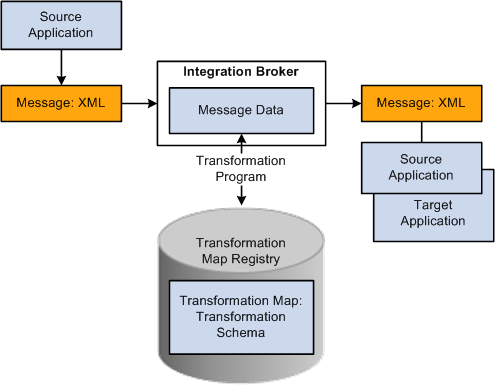Understanding the Transformation Framework
When an application sending a service operation uses a message structure different than the application receiving it, the message must be transformed in order to be accepted by the target application. HCM Transformation Framework uses definitional logic to transform messages. Using information you set up, the transformation framework applies the correct transformation logic to produce a message that complies with the target application requirements.
HCM Transformation Framework enables seamless integration among PeopleSoft applications as well as with third-party applications such as Oracle, SAP, and Siebel. Transformation schemas are associated with transformation maps, enabling you to quickly locate and modify a schema to respond to external changes.
The transformation map registry is made up of transformation maps. The transformation map defines the message properties of the message for both the target and source application. For each transformation map, create a transformation schema, an XML document that defines the message structure mapping between two applications.
When a message needs to be transformed in order to be successfully received by an application, you need to assign a transformation program with the message on the Integration Broker Relationships component (IB_RELATIONSHIP).
There are six transformation programs supported by the transformation framework:
HTMF_TR_IA, for inbound asynchronous communications.
HTMF_TR_IS, for inbound synchronous communications.
HMTF_TR_ISR: for the inbound synchronous response.
HTMF_TR_OA, for outbound asynchronous communications.
HTMF_TR_OS, for outbound synchronous communications.
HMTF_ TR_OSR for outbound synchronous responses.
Based on the type of transaction, choose the appropriate transformation program to associate with your message.
When an application publishes a message that requires transforming, PeopleSoft Integration Broker invokes the transformation program associated with the message. The transformation program determines which transformation map corresponds to the target message and applies the transformation schema to the message data using XSLT, an XML translation language. The transformation schema can modify the metadata or the message data itself to comply with the target application requirements. PeopleSoft Integration Broker repackages the transformed message data into an XML document that is structurally compliant with the target application. The Integration Broker can then deliver the message to the receiving application.
This diagram illustrates the flow of information from one application to another using HCM Transformation Framework:

See PeopleTools: PeopleSoft Integration Broker, "Applying Filtering, Transformation and Translation"
Before you create a transformation schema, it helps to understand the base XML document format used by PeopleSoft Integration Broker to package application data:
<?xml version="1.0"?>
<PeopleSoftMessageName>
<FieldTypes>
<RecordName1 class="R">
<fieldname1 type="CHAR"/>
<fieldname2 type="NUMBER"/>
...
</RecordName1>
<RecordName2 class="R">
<fieldname1 type="CHAR"/>
<fieldname2 type="NUMBER"/>
...
</RecordName2>
...
</FieldTypes>
<MsgData>
<Transaction>
<RecordName1 class="R">
<fieldname1>Fieldvalue</<fieldname1>
<fieldname2>Fieldvalue</<fieldname2>
...
<RecordName1>
<RecordName2 class="R">
<fieldname1 type="CHAR"/>
<fieldname2 type="NUMBER"/>
...
</RecordName2>
<PSCAMA class="R">
<AUDIT_ACTN>ActionCode</AUDIT_ACTN>
</PSCAMA>
...
</Transaction>
...
</MsgData>
</PeopleSoftMessageName>This format is then packaged into an XML document for transmission to the target application. If you have attached one of the supported framework transformation programs to the message, the transformation program identifies the appropriate transformation map and applies the transformation schema to the message, modifying its structure. The message is then repackaged into an XML document in its altered form and delivered.
Note: The transformation message must be supported by the transformation framework. Only supported programs can work with the transformation maps. You can also add configured Application Engine or XSLT transformation programs as part of the relationship definition independent of the transformation framework.
The transformation program can modify the following elements of the standard message structure:
Term |
Definition |
|---|---|
PeopleSoftMessageName |
The name of the message as it is defined in PeopleSoft using Application Designer. The transformation program can change the message name. |
FieldTypes |
The metadata for the records and their fields. The transformation program can select the fields required by the target applications and can change their names. |
Transaction |
Contains the data for the records and their fields and organizes them into a hierarchy. The record tags at each level contain the fields for that record. The transformation program can select one or more record subsets and their fields or just a subset of fields required by the target service operation and can change their names. |
PSCAM (PeopleSoft Common Application Message Attributes) |
The last record within a transaction that provides information about the entire transaction. The PSCAMA record contains fields that are common to all messages. The <PSCAMA> tag repeats for each row in each level of the transaction section of the message. The sender can set PSCAMA fields to provide basic information about the message, for example, to indicate the message language or the type of transaction a row represents. The transformation program copies this structure to the target message structure. |